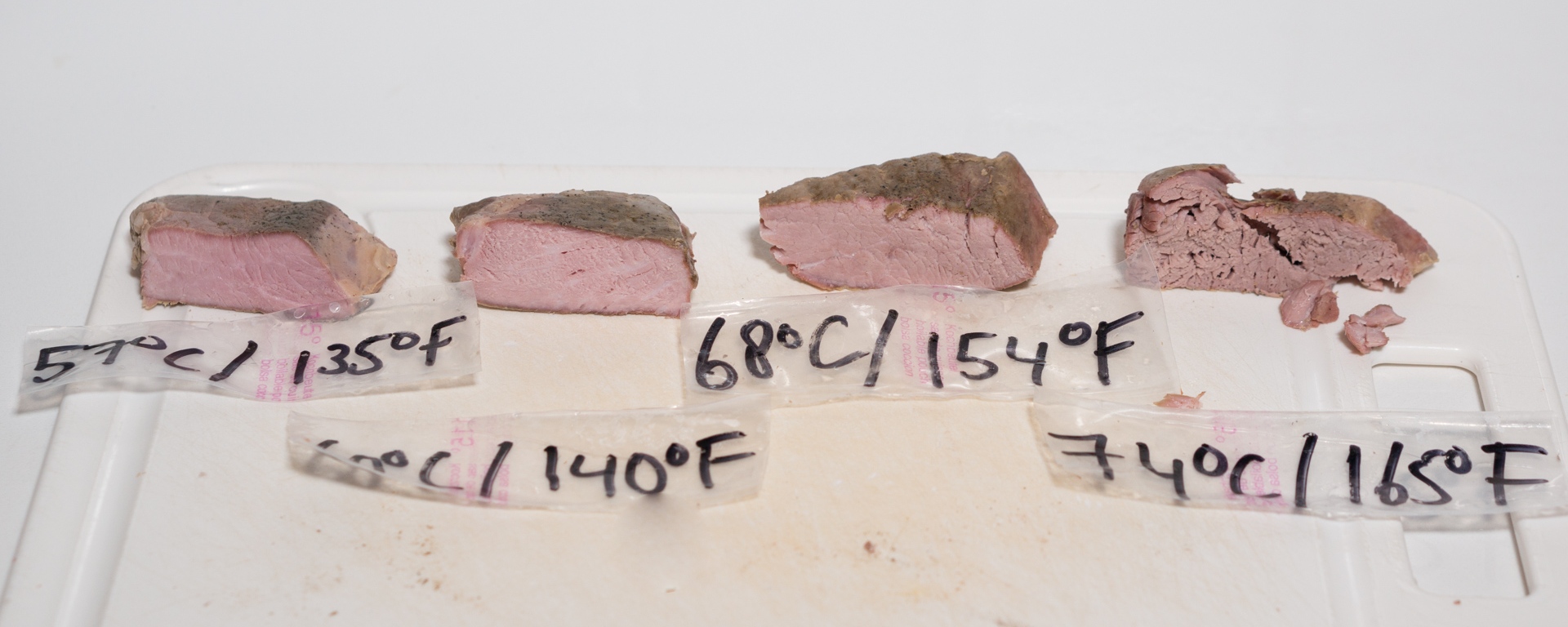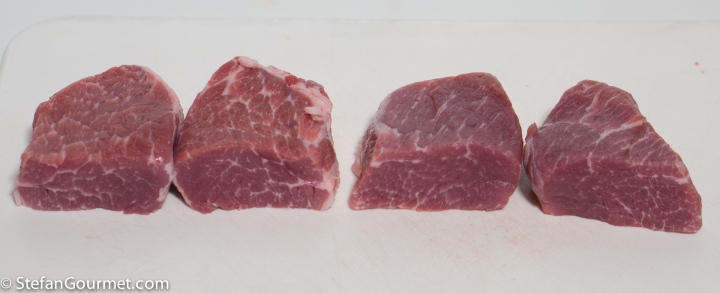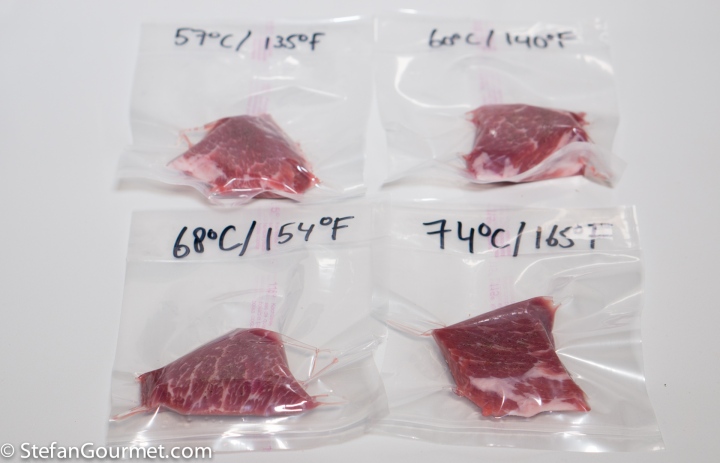Yesterday I was interviewed by Jason Logsdon of Amazing Food Made Easy for the Exploring Sous Vide Show. Click here to watch the full interview on Facebook. It was great to talk to Jason about topics like how to use the bag juices, sous vide stews, and many other sous vide topics.
Pork neck or pork shoulder, in the US referred to as pork butt, is one of my favorite cuts of pork. It is cheap and very flavorful thanks to the marbling and connective tissue. If you are familiar with my blog, it won’t come as a surprise that my favorite way to cook it is sous vide. I’ve been cooking this cut either for 24 hours at 57C/135F or for 24 hours at 74C/165F, depending on whether I wanted to have a juicy, tender, and pink result like in this recipe for char siu, or something more like pulled pork. Lately I have been interested in exploring temperatures in between, and so it is time for another side by side experiment. For this experiment I sliced 4 pieces out of a pork neck of approximately equal size and with a similar amount of marbling, to make the comparison as fair as possible.
I salted and vacuum sealed them, and decided to try the following temperatures, all for 24 hours: 57C/135F, 60C/140F, 68C/154F, and 74C/165F.
For cooking at 57C/135F it is important to scald the meat in very hot or boiling water (at least 77C/170F), after vacuum sealing but before sous vide cooking, to avoid a bad smell. To make the comparison as honest as possible, I gave all four pieces that treatment.
Each piece was cooked sous vide for 24 hours at the appropriate temperature.
I weighed each piece carefully before and after cooking to see how much liquid was lost (which does not only contain water but also melted fat and gelatin).
The amount of liquid that is lost goes up as the temperature goes up, as I’ve explained here. This was confirmed again by this experiment, as the weight loss was 25% for 57C/135F, 28% for 60C/140F, 33% for 68C/154F and 35% for 74C/165F. The difference in weight loss between 68C/154F and 74C/165F is so small because the meat has reached its maximum shrinkage (and therefore squeezing out of liquid) at 68C/154F. The additional loss at 74C/165F is mostly due to rendered fat and gelatin.
The meat cooked at 57C/135F is my favorite, very tender and juicy. It is a bit more pink, more juicy, and especially less firm than the one cooked at 60C/140F. Because of the long cooking time there is absolutely no risk associated with the pink color at 57C/135F. At 60C/140F it is still nice and you may prefer it if you are used to overcooked pork.
My least favorite was the piece cooked at 68C/154F. As we already saw from the weight it is about as dry as the one cooked at 74C/165F and although it is tender enough to chew easily, it is quite firm. The difference with the piece cooked at 74C/165F is striking, as the latter is falling apart. This happens when you cook meat at temperatures of 71C/160F and above. Although it tastes as dry as the piece cooked at 68C/154F, I prefer 74C/165F because it is softer and thus appears more tender. It will get much better if you pull the meat, heat up the juices from the bag, and mix the pulled meat with those juices.
As often with experiments, this calls for a follow up experiment. Next I’d like to try temperatures between 60C/140F and 68C/154F, as well as 71C/170F, and perhaps try 68C/154F for 36 hours instead of 24 to see if it will become less firm with more time.
For now I will stick to 57C/135F for 24 hours as my favorite time and temperature combination for this cut, or 74C/165F for 24 hours if I want to served it pulled.









Very well done, as usual. Thanks for sharing.
“… if you are used to overcooked pork.”
That made me really laugh. So polite! :-))
I am lucky to have a very ambitious butcher in my neighbourhood who offers dry aged pork. It is absolutely delicious. He recommends an even lower temperatur of 54°C for the pork chops.
LikeLike
Applauso! E ho anche fatto esercizio di English comprehension 😉
LikeLiked by 1 person
I just love reading about your sous vide experiments. A friend recently got a home cook version and plans on using silicon bags instead of the plastic, have you had any experience with that, I’d love to read about it?
We usually buy Pork Tenderloin but it’s become very expensive so I am on the lookout for something a bit more reasonable so thank you for the recommendation of the pork neck.
LikeLiked by 1 person
Came across this while looking for suggestion on a sous vide procedure (time/temp) for pork neck bones. I enjoyed reading about your experiment, but sadly am no closer to answering my original question!
LikeLiked by 1 person
You want to sous vide just the bones? What is your goal?
LikeLike
Would you recommend an increase in time/temperature when cooking roast, or do the same parameters apply to both roast and steak?
Your blog and experiments are a real inspiration, and i use your expertise as reference whenever i look up the web for times and temps.
Thank you!
LikeLiked by 1 person
Hi Victor, temperature never changes with size, and time only with short cooking times. If you are cooking for 24 hours or longer, the couple of hours extra that are needed to bring the core of a roast to temperature compared to a steak are negligible. Thanks for the nice compliment!
LikeLike